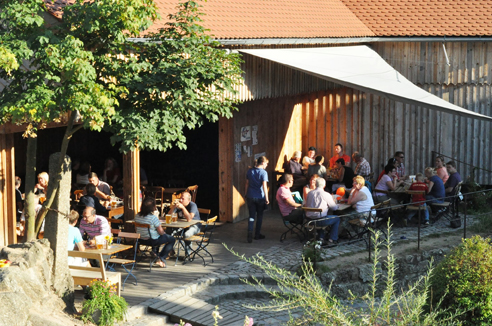Made and drunk communally, Bavaria’s Zoigl beer gives new meaning to homebrew.
Zoigl is not a beer, it’s a story. And the story’s one that runs counter to our age, a time in which people like to do their own things, in which we sit next to friends but stare at our phones, in which we enjoy—as Robert Putnam put it—“bowling alone.”
Here is the story: In a handful of villages on the eastern edge of Bavaria, there are several people brewing beer. But each village has only one brewery. So they share it. And they like it that way.
For example, in the town of Windischeschenbach (say it: vin-dish-ESH-en-bock) there is a crayon-yellow brewery building in an alley just off the main drag. There are 39 people in town with the right to brew here, that right being harder to acquire than season tickets at Lambeau Field. But they share the brewery. They take turns.
They take turns coming to unlock the front door in the morning. They take turns firing up the equipment, burning their share of logs to heat the coppers, mashing their share of pilsner and Munich malts, boiling their share of noble hops, pumping it into an attic coolship to cool overnight, then trucking it home in a trailer to fill up their own cellar fermenters to ripen it until it’s ready to serve.
Then they take turns serving it, unfiltered and straight from the tanks in pubs that are almost always connected to their homes. According to a calendar set months in advance, the brewers switch off opening up their pubs to the village, to each other and to anyone else passing through. Except for one or two hotels that dare to serve it year-round, typically there are only one or two Zoigl pubs open at any one time.
Locals keep copies of the Zoigl calendar so they know where to go. Travelers know, too, since few are here by accident. Then they all—try to imagine this if you can—they all share tables. They drink, they strike up conversation, and they eat together. Hardly any of them stare at their phones. That shared table is the Zoigltisch. It’s an important part of the story.
“In a restaurant, it’s different,” says Jochen Schreier, a village elder who, after showing me around Windischeschenbach’s Kommunbrauhaus, has taken me to the Schlosshof Zoiglstube. The Schlosshof is a cozy, well-wooded pub—they are all cozy, well-wooded and well-antlered here, far as I can tell—run by the Weiss family.
“In a Zoiglstube you have a bank director and a worker at the same table,” Schreier says. “They come to a Zoiglstube and they sit and they meet their neighbors.”
The same thing happens in the other Zoigl towns, like Neuhaus, which stands just across a stream from Windischeschenbach. But Neuhaus enjoys such a high and strategic piece of rock that it’s safe to assume its residents have always looked down on the neighbors.
The best place to do just that is the Schafferhof, a sprawling and lively farmhouse that becomes an obviously popular Zoigl outlet one weekend a month. The tables behind the house—which I find only because the others are full—have a view of the Burg, a cylindrical castle tower dating to 1300. The Schafferhof itself began as the castle farmyard, and was part of a monastery for a while. The upside-down urinating statue in front… OK, we don’t know what that’s about. But we dig it.
Food here is typical of Zoiglstube menus: loaded with local treats, and cheap. A half-liter of Zoigl, in all its orange-copper luminescence, runs the equivalent of $2.30. Large, fresh-baked pretzels served with Bavarian Obatzda cheese spread go for $3.40. Nothing on the menu costs more than $7, whether smoked trout or a platter loaded with cold wursts, cheeses and onions, all drizzled with vinaigrette.
We share our castle-view table with Joachim and Margaret Friedrich, aged 76 and 73, respectively. They come from near Bayreuth, less than an hour up the road, for the nature and the cycling—and for the Zoigl.
“It tastes good, that’s enough,” Joachim says.
“And it’s nice to sit here and to drink and eat,” Margaret says.
“And to talk with you!” Joachim adds. Then he shakes his head. “But sometimes we have problems.”
What kind of problems?
“Our problem is where to go tomorrow with the bicycle!”
I might have fibbed earlier, to make the correct impression. Zoigl is a beer—or at least, beer is important to the story. My favorite one of the day is at the Bahler Zoiglstube, with its pub and courtyard opened by the Witt family once every five or six weeks. Their Zoigl, on this night anyway, has a nutty, fresh-milled grain aroma that screams MALT.
Generally, Zoigl beers all have that bright coppery color with a haze that varies. Sweetish malt and bitterness ebb and flow but never leave the bounds of sensible moderation. It’s lovely without being special. The beer itself is not the distinction.
“The difference between Zoiglbier and normal beer is the place where it is brewed,” Schreier says.
“It’s brewed in a Kommunbrauhaus. And the Kommunbrauhaus belongs to more than one person.”
There are a few quirks. The brewhouse is wood-fired, all the brewers taking from the cellar log supply as needed. And each brewer has a slightly unique and well-guarded recipe. Indeed, the beers seem to vary a bit from place to place. I also suspect beer from the same place might taste a bit different when it re-opens again next month.
More often, the nuances go unnoticed, and you go right on drinking. And talking with your neighbors. •
There are 10 authorized Zoigl outlets in Windischeschenbach and seven in Neuhaus; others are scattered here and there. Several have rooms available for overnight stays. For more information on Zoigl, including calendars of when and where to find it, see Zoiglbier.de.










